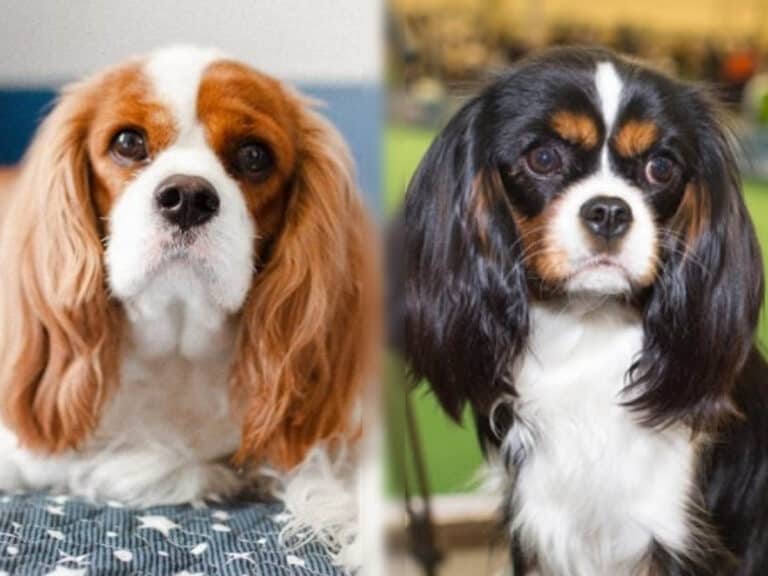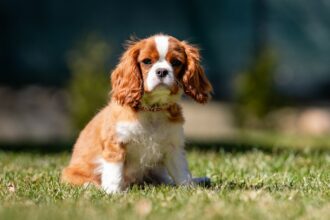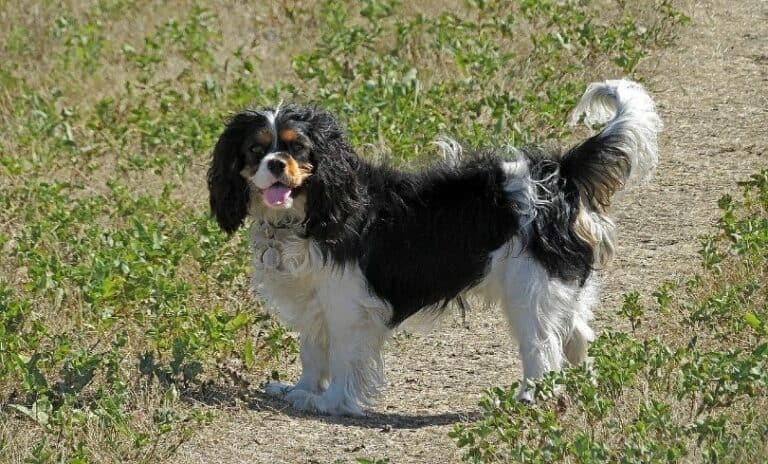If you’re interested in learning more about Spaniels, a good starting point is understanding the differences between the Cavalier and King Charles Spaniel.
While the Cavalier King Charles Spaniel and King Charles Spaniel share similarities, they are distinct breeds. Enthusiasts of these breeds will readily correct any misconception that they are the same. So, let’s delve into what sets them apart.
Visual Differences

At a Glance
Cavalier King Charles Spaniel
- Average height (adult): 12 to 13 inches
- Average weight (adult): 13 to 18 pounds
- Lifespan: 12 to 15 years
- Exercise: 1+ hours
- Grooming needs: Low to Moderate
- Family-friendly: Yes
- Other pet-friendly: Yes
- Trainability: Easy
King Charles Spaniel
- Average height (adult): 9 to 10 inches
- Average weight (adult): 8 to 14 pounds
- Lifespan: 10 to 12 years
- Exercise: 1+ hours
- Grooming needs: Moderate
- Family-friendly: Yes
- Other pet-friendly: Yes
- Trainability: Moderate
King Charles Spaniel Overview

Let’s start with the King Charles Spaniel.
Also known as the English Toy Spaniel, the King Charles Spaniel is smaller than the Cavaliers. It features a square, snub nose, and a dome-shaped head. The ears are long and luscious, and the eyes have a dark and innocent expression.
Known for their joyful and merry personality, King Charles Spaniels are fitting companions as dogs of the “Merry Monarchs.”
A Life of Luxury
Named after Charles I and Charles II of the 1600s, King Charles Spaniels were beloved by the monarchs. King Charles II even decreed that toy spaniels were the only dogs allowed in the House of Parliament.
During the reign of Charles I and II, King Charles Spaniels resembled Cavalier King Charles Spaniels with their flat heads and longer noses. However, during the Victorian Era, they were crossed with Asian flat-nosed breeds, resulting in the King Charles Spaniel we recognize today.
King Charles Spaniel Care
Exercise
King Charles Spaniels have a balanced mix of being active outdoors and relaxed indoors. They enjoy running and chasing outside, while indoors, they are content to relax alongside their owners.
Walking and playing fetch are great ways to keep your King Charles Spaniel active. During hot summer months, it’s best to exercise them in the cooler parts of the day due to their flat faces, which can make it challenging for them to regulate their body temperature.
Training
Primarily bred as lap dogs, King Charles Spaniels do not require intensive training for hunting purposes. However, some owners have successfully trained them for sports activities. Patience and positive reinforcement are key as they can be a bit stubborn during training due to their sensitive nature.
Grooming
With their long, wavy, silky coats, King Charles Spaniels need regular brushing at least twice a week to prevent matting and skin issues. Using a long-toothed comb to remove mats is essential. Bathing should be done every four to six weeks, along with trimming their face and feet. Regular nail trimming and teeth brushing are also important aspects of grooming.
Keep an eye on their floppy ears for any signs of dirt or infection to ensure their overall well-being.
Suitable for:
King Charles Spaniels are best suited for homes with low activity levels. They enjoy backyard play sessions but are equally happy to relax indoors. While they may be cautious around strangers, they are adaptable and affectionate companions that do well with children and other pets.
Cavalier King Charles Spaniel Overview

Cavalier King Charles Spaniels have flat heads and longer noses, reminiscent of the spaniels owned by King Charles I and II. However, at one point, the Cavalier King Charles Spaniel faced the threat of extinction.
On the Brink of Extinction
Cavalier King Charles Spaniels share a historical connection with King Charles Spaniels, with no clear distinction between the two breeds.
During Queen Victoria’s reign, breeding practices led to the crossbreeding of King Charles Spaniels with flat-nosed breeds, resulting in a different appearance from the spaniels during Charles I and II’s time. The popularity of the flat-nosed look nearly caused the traditional flat-head, long-nose style to disappear.
Fortunately, the old-style breed was revived in the 1920s, and efforts were made to differentiate the two breeds. The old-style breed was eventually named Cavalier King Charles Spaniel in honor of King Charles the Cavalier.
Cavalier King Charles Spaniel Care
Exercise
Unlike King Charles Spaniels, Cavaliers enjoy more vigorous exercise such as long walks, runs, and participation in canine sports. They are happy to unwind at home after a day of physical activity.
Cavalier King Charles Spaniels retain hunting and scenting instincts, making them suitable for hunting sports. However, it’s essential to be cautious as they may wander off if given the chance to roam off-leash.
Training
Cavaliers are known for their ease of training and eagerness to please their owners. They excel in basic training and can even be trained for hunting sports due to their innate abilities. Early socialization is crucial, but their sweet nature generally makes them good companions for children and other pets.
Grooming
Cavaliers have long, silky coats that require regular brushing once or twice a week. Their floppy ears should be checked for any signs of infection due to moisture retention. Regular nail trimming and teeth brushing are also part of their grooming routine.
Suitable for:
Cavalier King Charles Spaniels are ideal for active families, especially those interested in hunting activities. Their gentle and affectionate nature makes them great companions for children and other pets. Cavaliers are easy to train, more accepting of strangers, and require less grooming compared to other breeds.
Which Breed Is Right for You?
Both the King Charles Spaniel and Cavalier King Charles Spaniel are wonderful family pets known for their loyalty, affection, and gentleness. So, how do you choose between them?
King Charles Spaniels require more grooming and may have more health issues. They can be stubborn during training and are less suited for active families. However, they make great indoor companions.
On the other hand, Cavaliers are more active, trainable, and have fewer health issues due to their non-flat noses. Families looking for a pet to enjoy both indoor and outdoor activities will find the Cavalier a perfect fit.
Featured Image Credit: Left – Cavalier King Charles Spaniel – Shutterstock; Right – King Charles Spaniel – Shutterstock

